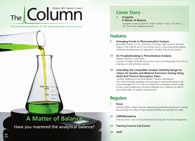Profiling PBDE Levels In Baltic Sea Fish
Fish from the Baltic Sea are a major source of lipophilic environmental pollutants for consumers in Finland. Surrounded by land, the Baltic Sea is one of the most threatened marine environments, making fish from the Baltic Sea a major source of lipophilic environmental pollutants including polybrominated diphenyl ethers (PBDEs).
Fish from the Baltic Sea are a major source of lipophilic environmental pollutants for consumers in Finland. Surrounded by land, the Baltic Sea is one of the most threatened marine environments, making fish from the Baltic Sea a major source of lipophilic environmental pollutants including polybrominated diphenyl ethers (PBDEs).
PBDEs were used as flame retardents on many products before the EU introduced regulations in 2004 to restrict their use. To determine the exposure of consumers in Finland to PBDEs as the result of eating Baltic Sea fish, researchers sampled fish from the Baltic Sea, freshwater lakes, and fish farms1. Corresponding author Hannu Kiviranta, from the National Institute for Health and Welfare in Kuopio, Finland, told The Column: “The motivation behind the study was that unfortunately the Baltic Sea is polluted by many organic pollutants and for protection of the population it is necessary to know current levels of various pollutants. There is also already EU maximum limit values for dioxins and PCBs in food and feed and maybe in the future also for brominated flame retardants. For legislation work we need to know the levels of these pollutants in fish.”
Over 200 samples of 17 edible fish were prepared and subsequently analyzed using gas chromatography–mass spectrometry (GC–MS) to screen for 15 PBDE congeners including BDE-28, -47, -66, -71, -75, -77, -85, -99, -100, -119, -138, -153, -154, -183, and -209. According to the paper, analyses showed high levels of BDE-209 in Baltic herring sampled near the city of Pori (Finland), and in farmed whitefish. - B.D.
Reference
1. R. Airaksinen et al., Environmental Science & Technology DOI: 10.1021/es505266p (2015).

A Matrix-Matched Semiquantification Method for PFAS in AFFF-Contaminated Soil
Published: April 14th 2025 | Updated: April 14th 2025Catharina Capitain and Melanie Schüßler from the Faculty of Geosciences at the University of Tübingen, Tübingen, Germany describe a novel approach using matrix-matched semiquantification to investigate per- and polyfluoroalkyl substances (PFAS) in contaminated soil.
Silvia Radenkovic on Building Connections in the Scientific Community
April 11th 2025In the second part of our conversation with Silvia Radenkovic, she shares insights into her involvement in scientific organizations and offers advice for young scientists looking to engage more in scientific organizations.











